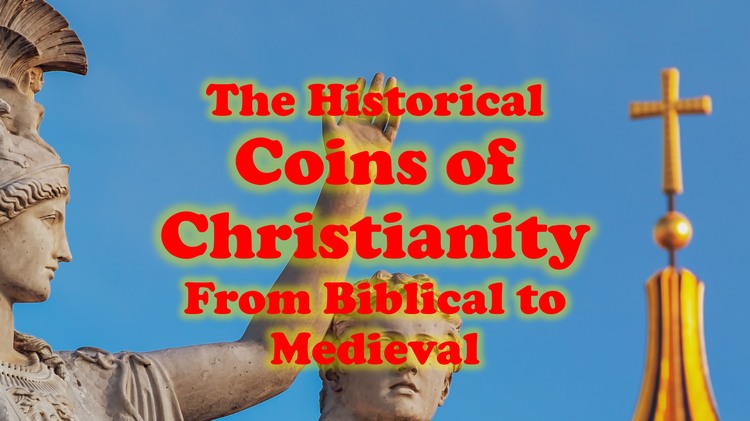
https://www.youtube.com/watch?v=GRMd1UbSR-k
This article and video is available at https://trustedcoins.com/christianity
Presented By Ilya Zlobin
PDF VERSION YOU CAN DOWNLOAD: https://trustedcoins.com/pdf/historical-progression-of-christianity/ancient-coins-of-christianity-collecting-guide.pdf
SLIDES POWERPOINT: https://trustedcoins.com/pdf/historical-progression-of-christianity/ancient-coins-of-christianity-collecting-guide-presentation-slides.pptx
SLIDES ON GOOGLE: https://drive.google.com/file/d/1neFwwnmEzOCb7JKZ6AdwxT2-EBrYDrEq/view?usp=sharing
LEARN ABOUT THE:
Lecture presented by ILYA ZLOBIN, a world-renowned ancient coin expert, enthusiast, author and dealer. He has produced dozens of informative articles and videos about ancient coins and coin collecting and shares the information with the world in an interesting, easy-to-follow and fun manner, available on his website www.TrustedCoins.com. Mr. Zlobin has been featured on the Pawn Stars TV show, see his segment on YouTube entitled Julius Caesar Silver Roman Coin.
https://www.youtube.com/watch?v=r6ky7J8RTz8
The Widow's Mite Coins
Mark 12:38-44 King James Version (KJV)
42 And there came a certain poor widow, and she threw in two mites, which make a farthing.
43 And he called unto him his disciples, and saith unto them, Verily I say unto you, That this poor widow hath cast more in, than all they which have cast into the treasury:
44 For all they did cast in of their abundance; but she of her want did cast in all that she had, even all her living.
Item: i64093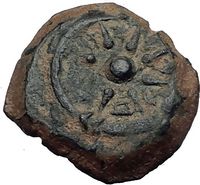
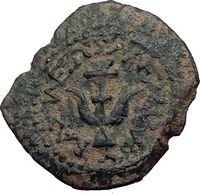
Alexander Jannaeus
Jewish King of the Hosmonean Kingdom 103-76 B.C.E.
Bronze 'Prutah' 16mm (3.24 grams) mint of Jerusalem 103-76 B.C.
Reference: Hendin 1150 (5th Edition); Hendin 469 (3rd Edition)
Star of eight rays surrounded by diadem, between the rays, paleo-Hebrew (Yehonatan the King).
Anchor, ΒΑΣΙΛΕΩΣ ΛΕΞΑΝΔΡΟΥ (of King Alexander).
Historically significant coin to those of both Jewish and Christian faiths, along with people that are interested in studying history. To the Jewish peoples, this coin represents an important historical Jewish king of the Hosmoneon dynasty. To Christians studying biblical history, this coin could be considered as a "Widow's Mite" from the bible. The prutah was the smallest (other than the half prutah) circulating coin in the area of Jerusalem during the time of Jesus Christ. It took about 10 prutah coins to buy a loaf of bread during those times. The bible does not make it clear which of the coins was donated by the poor widow, but it could be certain that it was a prutah or half prutah coin. Prutahs of Alexander Jananeus would have been common to circulation and some of his coins were struck in such vast numbers, they could be the least valuable coins to be considered a poor widow's mite. The exchange rate for a silver shekel would have been about 256 prutah coins. There were several Jewish rulers whom struck coins that could be considered a "widow's mite". And the conclusion that can be made that any circulating prutah coin of the area could have been given as donation in that story. Of course there are certain coin types that would be more plentiful or more scarce than others, but logically speaking, since a specific ruler's coin was not named in the bible, any prutahs circulating could have been the coin mentioned in the bible as the "Widow's Mite".
Item: i64115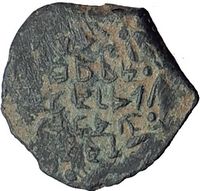
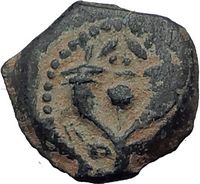
Jewish Coin of
John Hyrcanus I (Yehohanan) King of Judaea 134-104 B.C.E
Bronze 'Prutah' 14mm (1.74 grams) Jerusalem mint, struck circa 134-104 B.C.
Reference: Hendin 1139
Paleo-Hebrew inscription (Yehohanan the High Priest ...) within wreath.
Double cornucopia adorned with ribbons, pomegranate between horns, border of dots.
THE BIRTH OF JESUS and the MAGII
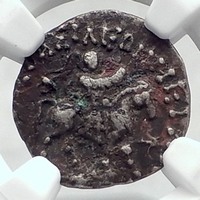
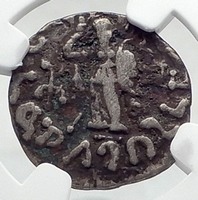
Indo-Scythian Kingdom in Northern India
King Azes II - Indo-Scythian King - Reigned: circa 35 B.C.- 12 B.C. or later, possibly up to 5 A.D.
Silver Drachm 15mm (1.90 grams) Struck circa 35 B.C. - 12 B.C. / 5 A.D.
Reference: HGC 12, 651 (Rare R1)
Certification: NGC Ancients VG 4285432-002
King with coat of mail, on horse, holding elephant goad, with Greek royal headband; Kharoshthi letter to right. Greek legend BAΣIΛEΩΣ BASIΛEΩN MEΓAΛOY AZOY "The Great King of Kings Azes".
Athena standing right, holding shield and making benediction gesture. Monogram to right and Kharohthi letter to left.
Kharoshti legend MAHARAJASA RAJADIRAJASA MAHATASA AYASA "The Great King of Kings Azes".
* Numismatic Note: This coin circulated around the time of the birth of Jesus Christ. It is from the area far east in the Indo-Scythian Kingdom in Northern India. This type of coin could have been carried by the Magii that went to see Jesus from the east. Gold, frankincense, and myrrh was available and traded in the area of northern India and was something that would be brought west from there. India was a great source for spices and other other exotic goods and caravans would travel from there bringing them for trade. It is believed that Jesus may have been born back as far back as 5 B.C. based on some of the biblical accounts. If this king lived up to 5 B.C. or later, which may be possible, he could have been then one of the kings that visited Jesus at his birth. Or if this coin was carried by the Magii, his coin could have came and visited Jesus. Since these kings may have traveled on horses, a king of those times would look like the king pictured on this coin. And it is also possible that one of his successors could have been some of the kings that visited Jesus at birth. Then again, they would have with them the circulating coin of the realm, and some of those which could have been the coin of this ruler. It is amazing to hold this coin connected to that amazing historical period.
JESUS CHRIST Birth STAR of BETHLEHEM Ancient Greek ANTIOCH Coin RAM NGC i80395
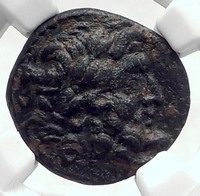
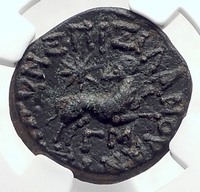
Greek city of Antioch on the Orontes in Seleukis and Pieria
STAR of BETHLEHEM ISSUE
Bronze 20mm (6.44 grams) Struck during Augustus' reign, circa 12/13 A.D. under governor Silanus
Commemorates the annexation of Judaea
Reference: RPC I 4268
Certification: NGC Ancients XF 4285435-015
Laureate head of Zeus right.
EΠI ΣIΛANOY ANTIOXEΩN, Ram leaping right, looking back at large star star (Constellation Aries), ΓM below (= year 43 of the Actian era).
* Numismatic Notes:
In his The Star of Bethlehem: The Legacy of the Magi, Dr. Michael Molnar sees in the reverse design the occultation of Jupiter by the moon in the constellation of Aries, which he identifies as the most probable candidate for the biblical account of the Star of Bethlehem that guided the Magi to the manager where Jesus was born.
It is believed by some that this coin refers to the "Star of Bethlehem" which may have been seen during the birth of Jesus Christ. In an article that can be found on Google by T.B. Cartwright entitled "Star of Bethlehem Coins - A Set of Serial Commemoratives" (see the article here: http://www.forumancientcoins.com/numiswiki/data/cartwright/Star%20of%20Bethlehem%20Coins.pdf) he writes:
" In 1999 , Dr. Michael Molnar , a Christian astronomer, published “The Star of Bethlehem - The Legacy of the Magi.” H is findings included the meaning behind the “Ram and Star” coins from Antioch along with the most likely “ heavenly alignment” constituting the “Star of Bethlehem . ” He concluded that the design was meant to recognize the birth of the Messiah in Judaea and that His birth occurred o n April 17, 6 BC. Since his book was published, I have continuously accumulated these coins by date and conducted research into the purpose of their minting . My conclusions not only confirm Dr. Molnar’s findings but also show that this “Star of Bethlehem” motif was used frequently between 6 AD and 253 AD . Ultimately, there are over 20 different dates for these commemorative coins and the dates cluster around major anniversary dates of Yeshua’s (Jesus’) “birth” and/ or “death and resurrection .” "
Founded by Seleukos I circa 300 B.C. with Greek and Macedonian settlers brought from the destroyed city of Antigoneia on the Orontes. The city was named after Seleukos' father with the purpose of being a western capital to guard against the northern expansion of the Ptolemaic kingdom. Eventually as many territories were lost, Antioch became the only capital of the Seleukid kingdom. Pompey the Great deposed the last king Antiochos XIII in 64 B.C. The Romans then made it a capital of a new Roman province and the seat of the Roman governors. There were temples of Olympian Zeus, Apollo in Daphne, hippodrome (built under the Seleukids and embellished by the Romans) and colonnaded main streets (being a gift from Herod the Great). It was an important center for the arts and learning.
SEE All Herod I, the Great Coins
Item: i70961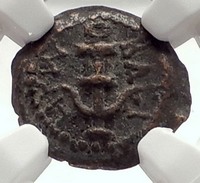
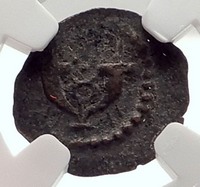
Kingdom of Judaea
Herod I, the Great - Jewish King: 40-4 B.C.
Bronze Prutah 13mm Jerusalem mint, struck circa 22-9 B.C.
Reference: Hendin 500 (3rd Edition); Hendin 1188 (5th Edition)
Anchor; HPW BACI around.
Double cornucopia with caduceus between, dots above.
This coin with the symbolism of the anchor may relate to the founding of Herod's magnificent port at Caesarea Maritima circa 22-9 B.C. Herod was the king during the birth of Jesus Christ, which modern scholars attribute to about as far back as 6 B.C. He is the man responsible for large building projects of architecture still known to this day including the wall surrounding the Great Temple, that a portion of is left of in Jerusalem, referred to as the "Wailing Wall"; and the fortress at Masada.
Saint Peter's Fish In Mouth Story
Matthew 17:24-27 King James Version (KJV)
24 And when they were come to Capernaum, they that received tribute money came to Peter, and said, Doth not your master pay tribute?
25 He saith, Yes. And when he was come into the house, Jesus prevented him, saying, What thinkest thou, Simon? of whom do the kings of the earth take custom or tribute? of their own children, or of strangers?
26 Peter saith unto him, Of strangers. Jesus saith unto him, Then are the children free.
27 Notwithstanding, lest we should offend them, go thou to the sea, and cast an hook, and take up the fish that first cometh up; and when thou hast opened his mouth, thou shalt find a piece of money: that take, and give unto them for me and thee.
Jesus Cleansing of the Temple
Matthew 21:12–17, Mark 11:15–19, and Luke 19:45–48) and near the start in the Gospel of John (at John 2:13–16
John 2:13-16 King James Version (KJV)
13 And the Jews' passover was at hand, and Jesus went up to Jerusalem.
14 And found in the temple those that sold oxen and sheep and doves, and the changers of money sitting:
15 And when he had made a scourge of small cords, he drove them all out of the temple, and the sheep, and the oxen; and poured out the changers' money, and overthrew the tables;
16 And said unto them that sold doves, Take these things hence; make not my Father's house an house of merchandise.
The 30 Pieces of Silver Judas Sold Out Jesus For
Matthew 26:15 King James Version (KJV)
15 And said unto them, What will ye give me, and I will deliver him unto you? And they covenanted with him for thirty pieces of silver.
The 30 Pieces of Silver Judas Sold Out Jesus For
SEE ALL Tyre SHEKELS
TYRE SHEKEL Ancient BIBLICAL Silver Jewish Temple Tax Greek Coin NGC i69562
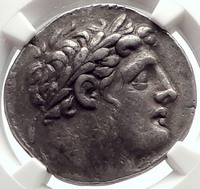
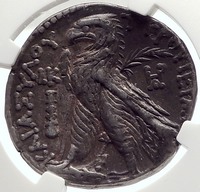
Greek city of Tyre in Phoenicia
Authentic "Jewish / Christian Biblical Coin" of Historical Importance
Silver 'Shekel' Tetradrachm 27mm (13.99 grams) Tyre mint, dated year 20, struck 107/106 B.C.
Reference: Sear 5918 var.; HGC 10, 357; DCA Tyre supplement 2.20, 58; BMC Phoenicia 91
Certification: NGC Ancients XF Strike: 5/5 Surface: 4/5 4253889-011
Laureate head of beardless Melqarth right, lion's skin knotted around neck.
TYPOY IEPAΣ KAI AΣYΛOY, Eagle standing left on beak of ship, carrying palm under right wing; in field to right, HPA monogram; in field to left, club and LK (date) above it; Phoenician bet between legs. th
In the centuries following the Macedonian conquest, Tyre was subject first to the Ptolemaic Kingdom of Egypt, then at the end of the 3rd century, to the Seleucids of Syria. In 126/5 the city regained its autonomy and commenced a remarkable issue of silver and bronze coins extending well into the Roman Imperial period.
The famous silver tetradrachms ('shekels') of this series have achieved notoriety as the most likely coinage with which Judas was paid his 'thirty pieces of silver' for the betrayal of Christ. This type of coin would also have been the type of coin that the "money changers" at their tables in the Temple courtyard would have for exchange for the Great Temple tax that would be paid. The silver content of these coin types was uniform throughout their history of being minted, and because of the absence of living human rulers on it, it was allowed to be used in the Great Temple. The tax was 1/2 shekel coin per Jewish person per year. This coin would be good for a tax for two people to contribute during their visit. Very important, historically-significant coin to both of the Jewish and Christian faiths.
The Second Temple tax coin that the Jewish people of Jerusalem paid in, known as the "Shekel of Tyre".
A coin like this is known to the Christian Gospels as the coin found in "St. Peter's Fish".
These are the coins that other coins were being exchanged for when Jesus Christ "attacked" the money changers, flipping over their tables and whipping them. This narrative is known as the "cleansing of the Temple".
It is believed that it is either this type of silver coin, or another from the local city of Antioch with the Roman emperor's portrait that could have been one of the infamous "Thirty pieces of silver" bribe paid to Judas to betray Jesus.
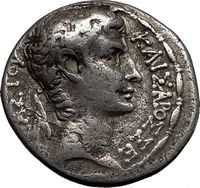
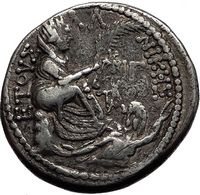
Augustus - Roman Emperor: 27 B.C. - 14 A.D.
Infamous '30 Pieces of Silver' Judas' Betrayal of Jesus Christ Biblical Coin
Silver Tetradrachm 26mm (14.27 grams) of Antioch mint, Struck 1 B.C. / 1 A.D.
Dated year 31 of the Actian Era and Cos. XIII
Reference: McAlee 186; Prieur 56; RPC I 4157; DCA 400. Rare.
ΚΑΙΣΑΡΟΣ ΣΕΒΑΣΤΟΥ, Laureate head right.
ETOVΣ AΛ (Actian era date) NIKHΣ, Tyche seated right on rocky outcropping, holding palm frond; below, half-length figure of river-god Orontes swimming right; in right field, monogram (=ΥΠΑTOY) and IΓ (consular date) above monogram (=ANTIOXIEΩN?).

The Antiochan tetradrachm is one possibility for the identity of the coins making up the thirty pieces.
The Biblical Tribute 'Render Unto Caesar' Coin Types
Mark 12:14-17 King James Version (KJV)
14 And when they were come, they say unto him, Master, we know that thou art true, and carest for no man: for thou regardest not the person of men, but teachest the way of God in truth: Is it lawful to give tribute to Caesar, or not?
15 Shall we give, or shall we not give? But he, knowing their hypocrisy, said unto them, Why tempt ye me? bring me a penny, that I may see it.
16 And they brought it. And he saith unto them, Whose is this image and superscription? And they said unto him, Caesar's.
17 And Jesus answering said unto them, Render to Caesar the things that are Caesar's, and to God the things that are God's. And they marvelled at him.
Matthew 22:17-21 King James Version (KJV)
17 Tell us therefore, What thinkest thou? Is it lawful to give tribute unto Caesar, or not?
18 But Jesus perceived their wickedness, and said, Why tempt ye me, ye hypocrites?
19 Shew me the tribute money. And they brought unto him a penny.
20 And he saith unto them, Whose is this image and superscription?
21 They say unto him, Caesar's. Then saith he unto them, Render therefore unto Caesar the things which are Caesar's; and unto God the things that are God's.
The two most possible contenders are the Tiberius denarius with Livia reverse and the Augustus silver denarius with the Gaius and Lucius brothers on the reverse. However archeological evidence shows that the Augustus coin was a lot more prevalent in Jerusalem at the time so is the more likely candidate of the two.
See all the RENDER UNTO CAESAR Coins
AUGUSTUS Biblical Jesus Christ Time RENDER CAESAR Silver Roman Coin NGC i80680
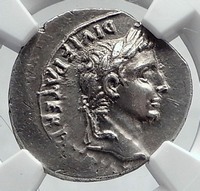
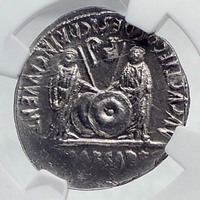
Augustus - Roman Emperor: 27 B.C. - 14 A.D.
THE BIBLICAL TRIBUTE PENNY
Silver Denarius 19mm (3.79 grams) Lugdunum (Lyon) mint. Struck 2 B.C. - 2 A.D.
Reference: RSC 43; RIC I 207
CAESAR AVGVSTVS DIVI F. PATER PATRIAE, his laurel head right.
C . L . CAESARES AVGVSTI F . COS . DESIG . PRINC . IVVENT., Caius and Lucius Caesars standing facing, shields and spears between them; above, between the spears, simpulum and lituus turned inwards.
* Numismatic: There are two types of silver Roman coins that were described in the Tribute Penny, with this being one of the more likely two candidates, as it was a more common to circulation in the area where Jesus Christ lived.
TIBERIUS 36AD Silver BIBLICAL Roman Coin Jesus Christ RENDER CAESAR NGC i76850
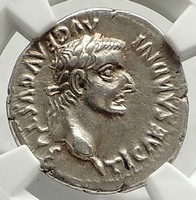
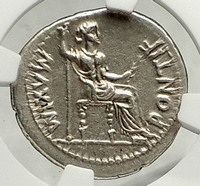
Tiberius - Roman Emperor: 14-37 A.D.
THE BIBLICAL TRIBUTE PENNY
Silver Denarius 20mm (3.66 grams) Lugdunum mint, struck circa 18-35 A.D.
Reference: RIC I 30; Lyon 152; RSC 16a
Certification: NGC Ancients Ch XF Strike: 5/5 Surface: 4/5 4934586-001
TI CAESAR DIVI AVG F AVGVSTVS, laureate head of Tiberius right.
PONTIF MAXIM , Livia (as Pax), spear in right hand, olive branch in left, seated right on chair.
This is the coin described in the bible as the "tribute penny".
https://www.youtube.com/watch?v=6xP8i2TE6C0
SEE ALL Pontius Pilate Coins Available

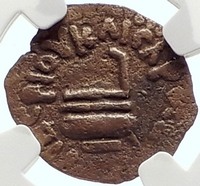
Judaea - Holy Land Area
Pontius Pilate - Prefect of Judaea: 26-36 A.D.
under Tiberius - Roman Emperor: 14-37 A.D.
Bronze Prutah 16mm (2.08 grams)
Struck at the mint of Jerusalem 29/30 A.D.
Reference: Hendin 1341 (5th Edition); Hendin 648 (3rd Edition)
Certification: NGC Ancients Ch VF Strike: 4/5 Surface: 4/5 4680615-006
Obverse: Three bound ears of barley, the outer two ears droop, surrounded by IOYΛIA KAICAPOC.
Reverse: Libation ladle (simpulum) surrounded by TIBEPIOY KAICAPOC (of Tiberius Caesar) and date LIC (Year 16).
* Numismatic Note: This authentic ancient coin was used in everyday trade during the lifetime of Jesus Christ in Jerusalem and surrounding areas. An important historically significant biblical coin of emperor Tiberius during whose rule Jesus Christ was crucified under the Roman prefect of Judaea, Pontius Pilate.
Roman Procurator coinage were coins issued by the Roman Procurators and Prefects of the province of Judaea between 6 - 66 A.D. They minted only one denomination and size, the bronze prutah. Not all of the Procurators issued coinage. The procurators / prefects of the province of Judaea under the Romans that issued coins were Coponius, Marcus Ambibulus, Valerius Gratus, Pontius Pilate, Antonius Felix and Porcius Festus. The last three Procurators Lucceius Albinus, Gessius Florus and Marcus Antonius Julianus didn't issue any coins as the tidings of the First Jewish-Roman War was in the air brewing during emperor Nero's reign and the leaders of the revolt started issuing their own coins.
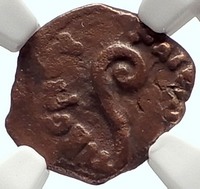
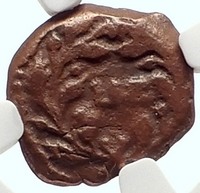
Judaea - Holy Land Area
Pontius Pilate - Prefect of Judaea: 26-36 A.D.
under Tiberius - Roman Emperor: 14-37 A.D.
Bronze Prutah 15mm (1.89 grams)
Struck at the mint of Jerusalem Jerusalem 30/31 A.D.
Reference: Hendin 1342 (5th Edition)
Certification: NGC Ancients VF Strike: 4/5 Surface: 4/5 4680615-010
Obverse: Lituus, surrounded by TIBEPIOY KAICAPOC (= Tiberius Caesar).
Reverse: Date LIZ (= year 17 of Tiberius' reign = 30/31 A.D.) within wreath.
SEE ALL Nero Coins Available
NERO Authentic Ancient 67AD Rome Genuine Silver Denarius Roman Coin ICG i80685
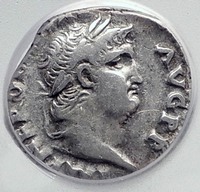
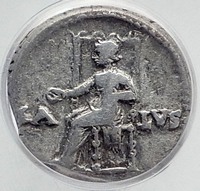
Nero - Roman Emperor: 54-68 A.D.
Silver Denarius 17mm Rome mint, struck 67-68 A.D.
Reference: RIC 72; RSC 320
IMP NERO CAESAR AVG PP, laureate head right.
SA-LVS to either side of Salus seated left holding patera.
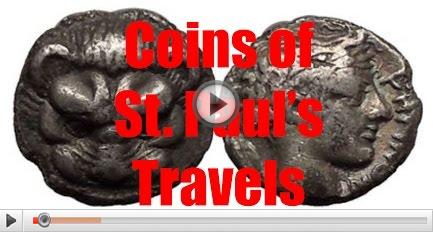
https://www.youtube.com/watch?v=OyWvRoN_qUs
The goal of this guide is to make it easy to learn about the ancient coins in circulation during the lifetime of Jesus Christ and the spread of Christianity. Many of the links included in this guide will take you to search my eBay ancient coin store which has a selection of over 14,000 coins and artifacts, with many of the coins in this guide available to collect for someone interested in this topic. It is also a great way to study and a familiarize yourself with the types of ancient coins St. Paul may have encountered during his travels.
This is a list of all the cities and areas he visited on his travels. Most of these cities actually issued coins. If not the city, the coins of the area, province or region may be available to view. There are people, such as bible scholars and others interested in the topic, who put together entire collections that follow St. Paul's four journeys. A coin of the area may also make a great gift for someone of the faith.
The cities that issued coins are easily clickable and you can actually see the coins from there, which are available for sale. Please note that it looks that eBay auto-corrects some spellings, so for some of the terms, you may need to click the [ Return to original search ] link to actually see the coins available, this is noted for coins of Philippi and Rhegion.
St. Paul's 1st Journey (Acts: 13:1-14:28)
See also related:
![]() Download this article by right-clicking here and selecting save as
Download this article by right-clicking here and selecting save as
SEE ALL Ephesos COINS & Romanized spelling Ephesus
EPHESOS in IONIA 102BC Silver Greek Cistophorus Tetradrachm Coin NGC i73695
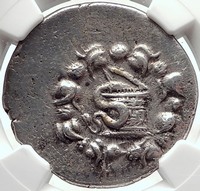
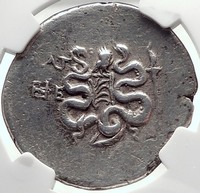
Greek city of Ephesos in Ionia
Silver Cistophoric Tetradrachm (Cistophorus) 30mm. Dated Civic Year 33, 102/101 B.C.
Reference: BMC -. SNG Copenhagen -. DCA 325, K37.
Cista mystica with serpent; all within ivy wreath.
Empty bow case between two serpents; owl above, palm below, ΛΓ (date) / EΦE in left field, lit torch in right field
Saint Paul is Arrested in 58 B.C. under Porcius Festus in Jerusalem
Acts 25:12-26
Biblical Jerusalem Saint Paul NERO PORCIUS FESTUS Ancient Roman Coin NGC i70853
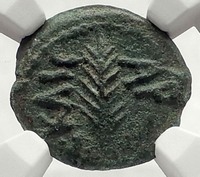
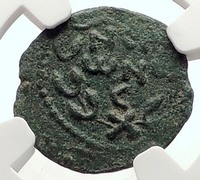
Biblical Jerusalem and Judaea under Roman Administration
Porcius Festus, Procurator under Nero - Roman Emperor: 54-68 A.D.
Bronze Prutah 16mm Jerusalem mint, struck 58/59 A.D.
Reference: Hendin 1351 (5th Edition); Hendin 653 (3rd Edition)
Greek letters KAICAPOC (Caesar) and date LЄ (year 5=58/59 A.D), palm branch.
Greek letters NЄP WNO C (Nero) in wreath tied at the bottom with an X.
SEE ALL Jewish-Roman WAR COINS awailable
Authentic Ancient JEWISH WAR vs ROMANS 67AD Historical JERUSALEM Coin NGC i80686
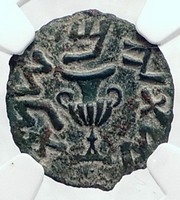
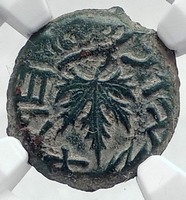
Jewish Coin of the First Jewish-Roman War "Great Revolt"
Bronze Prutah 17mm
Struck Year 2 of the Jewish War at the Jerusalem mint, April 67 - March 68 A.D.
Reference: Hendin 1360 (5th Edition); Hendin 661 (3rd Edition)
Jewish Amphora with broad rim and two handles; around Hebrew inscription for Year 2.
Vine leaf on a branch and the Hebrew inscription: 'The Freedom of Zion'.
Authentic ancient coin struck by the Jews revolting in Jerusalem, which culminated in the sacking and destruction of the Second Temple by the Romans. After their victory, the Romans celebrated the victory over the Jewish people on coinage known as "Judaea Capta" with several variants, most wide-spread one being a mourning Jewish woman under a military trophy. Meshorer, an authority and author who wrote many books on Jewish coins, writes that the amphoras "on the Jewish issues may symbolize the sacred libations of wine made in the Temple. The vessels depicted on the coins of the revolt are not copies of the Roman amphoras; they are Jewish and of different style than the classical Greco-Roman models represented on the coinage of Valerius Gratus." Historically significant and important piece of history, especially to those of Jewish heritage.
SEE ALL Judaea Capta Coins
VESPASIAN Authentic Ancient JUDAEA CAPTA Superb Silver Denarius Coin NGC i79640
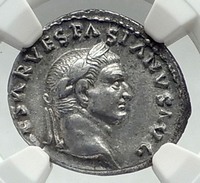
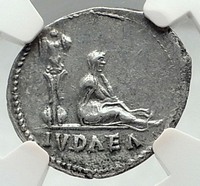
Vespasian - Roman Emperor: 69-79 A.D.
"Judaea Capta" Silver Denarius 20mm (3.39 grams) Rome mint: 69-70 A.D.
Reference: RIC 2; Cohen 226; BN 23; B.M.C. 35; Hendin 759 (3rd Edition); Hendin 1464 (5th Edition)
Laureate head of Vespasian right; around IMP CAESAR VESPASIANVS AVG.
Jewess seated right mourning below right of trophy; in exergue, IVDAEA.
Possibly the best Judaea Capta denarius available.
Early CHRISTIAN Roman Time 100-300AD GOLD Jesus FISH in GREEK Artifact i66773
Item: i66773
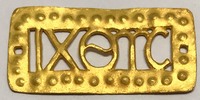
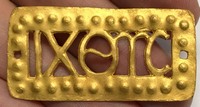
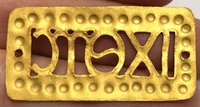
100-300 A.D. Gold Roman Era Greek Inscribed Ichthus 'Fish' Plaque - Artifact
| Weight: 8.72 grams | Material: Gold | 4.8 x 2.4 x 0.1 centimeters
ΙΧΘΥΣ would be a very early ancient Christian inscription having to do with Christianity with it translating to fish in English, thus what we know as the 'Jesus Fish'. ΙΧΘΥΣ (ichthys), or also ΙΧΘΥϹ with a lunate sigma, is an acronym/acrostic for "Ἰησοῦς Χριστός, Θεοῦ Υἱός, Σωτήρ" (Iēsous Christos, Theou Yios, Sōtēr), which translates into English as "Jesus Christ, Son of God, Saviour".
SEE all Great Persecution coins available
310AD Anonymous Ancient PAGAN Roman Coin GREAT PERSECUTION of CHRISTIANS i64464
Item: i64464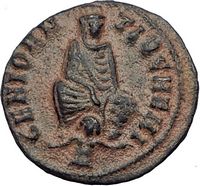
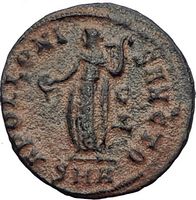
Anonymous "Great Persecution of Christians Issue"
struck under: Maximinus II, Daia - Roman Emperor: 308-313 A.D. -
Bronze Quarter-Nummus 16mm (1.42 grams) Antioch mint, circa 310-313 AD.
Reference: Vagi 2954; Cohen 1 [Julian II], van Heesch 92; McAlee 170; Failmezger 229
GENIO ANTIOCHENI, Tyche of Antioch enthroned facing, river god Orontes swimming at her feet.
APOLLONI SANCTO, Apollo standing left holding patera & lyre, C over Δ in field to right , SMA in exergue.
PAGAN COINAGE OF THE GREAT PERSECUTION
Though formerly attributed to the period of Julian II, these pieces were struck c. 305-313 as part of The Great Persecution of Christians in the east by Diocletian, Galerius and Maximinus II Daia. Though the persecution of Christians had occurred under many previous regimes since the 1st Century, it was pursued assiduously by the Tetrarchs. Indeed, it was only halted (it would seem) when they determined that it was working to the advantage of Constantine the Great, who embraced the religion as a result. Associated with the persecution is a series of 'autonomous' coins struck at the cities of Antioch, Nicomedia and Alexandria. The bulk of these coins were probably struck c. 310-312 under Galerius or Maximinus Daia (though the issues of Nicomedia can perhaps be attributed to Galeria Valeria, the second wife of Galerius). The issues of Alexandria occur in two denominations and celebrate Serapis and Nilus. With the voluminous issues of Antioch we find a variety of mint marks, officinae and control marks, which suggest the output was large and complex. Depicted on the issues of Antioch are some of the city's most famous statues: the Tyche erected by Eutychides (a pupil of Lysippus), the Apollo by Bryaxis of Athens, and possibly the Zeus Nikephoros of the Temple of Apollo at Daphne which Antiochus IV commissioned for his great festival of 167 B.C.
Milvian Bridge Coin
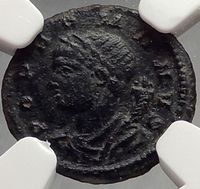
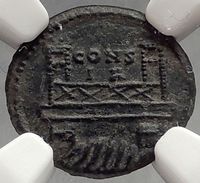
Constantine I 'The Great' - Roman Emperor: 307-337 A.D.
Bronze AE4 13mm (1.20 grams) Constantinople mint, struck circa 330 A.D.
Reference: RIC 21
POP ROMANVS, draped bust of Genius left, cornucopiae on shoulder.
Ostensibly the Milvian Bridge over the river Tiber, CONS/IA above bridge.
Struck in commemoration of the re-foundation of Byzantium as Constantinople, the reverse depicts the famed Milvian Bridge over the Tiber, where Constantine defeated Maxentius in October of AD 312.
SEE all Nicaea coins available
Council of Nicaea Held under Constantine in 325 A.D.
Item: i73708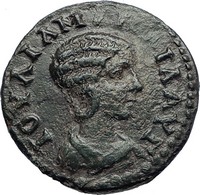
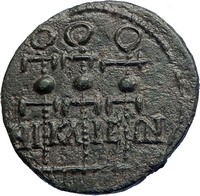
Julia Mamaea - Augusta: 222-235 A.D.
Bronze 21mm (4.60 grams) of Nicaea in Bithynia circa 222-235 A.D.
Reference: BMC 105v; SNG Cop 521v (legend. breaks), SGI 3421
IOVLIA MAMAIA AVΓ, draped bust right.
N-IK-AI-E-WN, between and beneath three legionary standards.
See all the Rome's Founding by Romulus & Remus Commemorative coins
CONSTANTINE I the GREAT 330AD Romulus Remus WOLF Rome Ancient Roman Coin i63283
Item: i63283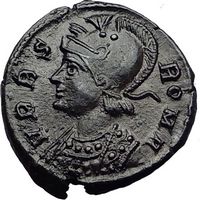
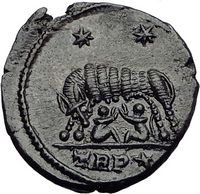
Constantine I 'The Great' - Roman Emperor: 307-337 A.D.
Rome's Founding by Romulus & Remus Commemorative
Bronze AE3 / Nummus 17mm (3.02 grams) Trier (Treveri) mint, struck 332-333 A.D.
Reference: RIC 547
VRBS ROMA, helmeted, mantled bust of Roma left.
She-wolf standing left suckling Romulus and Remus, two stars above TRP⁎ in exergue.
By circa 330 A.D., Constantine the Great completed his new capital for the Roman empire and called it Constantinople after himself, originally the ancient Greek city named Byzantium. Constantinople lay in a strategically important location and could be considered the continuation of the Roman empire in the east until about 1453 A.D. when it fell to the Ottoman Turks. For this momentous occasion, he issued two coin types commemorating this event, with one celebrating Rome and the other Constantinople. The type that commemorated Rome had the personification of Rome, Roma with the inscription VRBS ROMA and the founders of Rome, Romulus and Remus on the reverse suckling the mythical she-wolf. The type that commemorated Constantinople had the personification of Constantinople on the obverse and Victory on a galley sailing with a shield. This was a great way for Constantine the Great to pay homage to both Rome and Constantinople as now the Roman empire had two official capitals.
See all Founding of a new Roman Capital - Constantinople Commemorative coins
CONSTANTINE I the GREAT Founds Constantinople Ancient Roman Coin NGC i80336
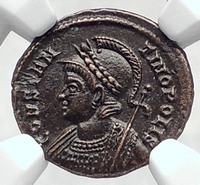
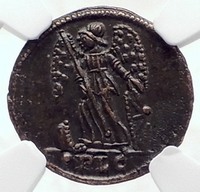
Constantine I 'The Great' - Roman Emperor: 307-337 A.D.
Founding of a new Roman Capital - Constantinople Commemorative
Bronze AE3 17mm Lyons mint, struck circa 330-331 A.D.
Reference: RIC VII 246
Certification: NGC Ancients Ch AU 2066328-360
CONSTANTINOPOLIS, Constantinopolis helmeted, laureate bust left, holding scepter over shoulder.
Victory (Nike) standing left, stepping on galley prow, cradling scepter and resting hand on shield; mintmark •PLG in exergue below.
Constantinopolis, built on the site of the ancient Byzantium by Constantine the Great, who called it after his own name and made it the capital of the Roman empire. It was solemnly consecrated A.D. 330. It was built in imitation of Rome. Thus it covered 7 hills, was divided into 14 regiones, and was adorned with various buildings in imitation of the capital of the Western world. Its extreme length was about 3 Roman miles ; and its walls included eventually a circumference of 13 or 14 Roman miles. It continued the capital of the Roman empire in the east until its capture by the Turks in 1453.
SEE ALL Constantine in Chariot to Heaven with Hand of God Accepting Him Coins
CONSTANTINE I the Great CHARIOT to GOD HAND HEAVEN Ancient Roman Coin NGC i78724
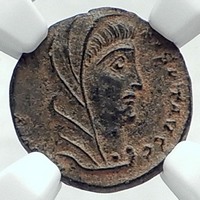
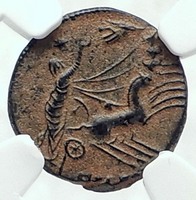
Constantine I 'The Great' - Roman Emperor: 307-337 A.D.
Divus Constantine Posthumous Christian Deification Issue
Constantine in Chariot to Heaven with Hand of God Accepting Him
Bronze AE4 14mm Struck circa 337-340 A.D.
DV CONSTANTINVS P T AVG G, Veiled head of Constantine right.
Constantine I, the Great, in quadriga (a four horse chariot) riding heavenward right reaching for manus Dei (hand of God) reaching down toward him above.
* Numismatic Note: After the passing of Constantine the Great, a series of coins were issued as was done with many previous emperors, the inscription "DV" stands for "divus" or divine. It was common practice in ancient times to deify an emperor or empress that passed, but this was the first time that it was more Christian-oriented with the motif of him going towards the heavens. It was Constantine that saw a vision from God that said to him "HOC SIGNO VICTOR ERIS" or "By this sign, conquer" and he painted the Chi-Rho (a monogram of Jesus Christ also known as a Christogram) on the shields of his army and wound beating the opposing army. Interesting to note that even though he professed Christianity then, he waited until his deathbed to be baptized, to cleanse the sins he committed being an emperor, in an especially violent period of history. Constantine the Great is also known as Saint Constantine as he is the one that spread Christianity to Roman empire and making it the official religion. It was also the city of Constantinople that he founded (on the site of an older Greek city called Byzantion) that could be considered the continuation of the Roman empire and a bastion of Christianity for almost a 1000 years after the fall of Rome in the later 1400's A.D.
SEE all Saint Helena coins
SAINT Helena Mother of Constantine I the Great 319AD RARE Roman Coin NGC i77889
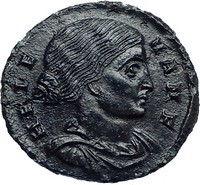
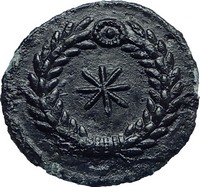
'Saint' Helena - Roman Empress 324-328/330 A.D.
as Nobilissima Femina (AD 306-324)
AE3 or BI Nummus 19mm (2.55 grams, 12 h) Thessalonica, struck under Constantine I, 318-319 A.D.
Reference: RIC VII 50
HELENA N F, draped bust of Helena right, seen from front, hair brushed straight and bound in small chignon. Eight-pointed star within wreath terminating in large jewel.
SEE all Roman Cross / Chi-Rho / Christogram / Labarum / Staurogram / Coins
THEODOSIUS II 425AD Authemtic Ancient Roman Coin Cross within wreath i79284
Item: i79284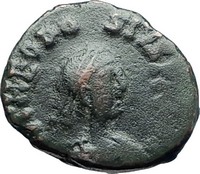
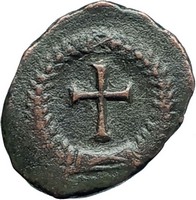
Theodosius II - Roman Emperor: 408-450 A.D.
Bronze AE4 13mm (1.10 grams) Struck circa 425-435 A.D.
D N THEODOSIVS P F AVG, Pearl-diademed, draped and cuirassed bust right.
Cross within wreath.
POEMENIUS Revolt in name of Constantius CHI-RHO NGC Certified Roman Coin i80522
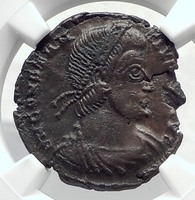
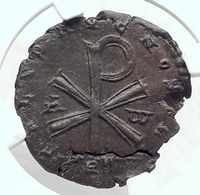
Usurper Poemenius
in the name of
Constantius II - Roman Emperor: 337-361 A.D.
Bronze AE2/Centenionalis 24mm (5.43 grams)
Ostensibly of the Revolt of Poemenius, Trier mint, 2nd officina., struck mid 253 A.D.
Reference: RIC 332. LRBC 67. Rare!
D N CONSTAN - TIVS P F AVG, Pearl-diademed, draped and cuirassed bust of Constantius II right
SALVS AVG NOSTRI Exergue: TRS☼, Large Chi-Rho; A - ω flanking.
The Chi-Rho is the monogram of Jesus Christ. The A and W on the left represent the Alpha and Omega which Christ was described as in the book of Revelations.
See all HOC SIGNO coin
VETRANIO inname of CONSTANTIUS II HOC SIGNO VICTOR ERIS Roman Coin NGC MS i69316
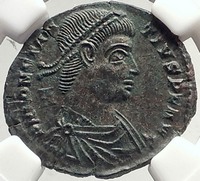
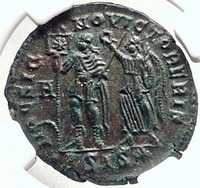
Vetranio - in the name of:
Constantius II - Roman Emperor: 337-361 A.D.
Constantine the Great's Vision - "By This Sign You Shall Conquer"
Bronze Centenionalis 24mm (5.24 grams) Siscia mint:, 2nd Officina, under Vetranio, struck 350 A.D.
Reference: RIC VIII 282
D N CONSTANTIVS P F AVG, Pearl-diademed, draped and cuirassed bust right; A to left.
HOC SIGNO VICTOR ERIS ('by this sign you shall conquer') / •BSIS✷, emperor Constantius II standing facing, head left, labarum with Christogram on banner in right hand, transverse spear in left, being crowned with wreath in right hand by Victory standing facing, head left, palm in left hand over shoulder.
The legend, Hoc Signo Victor Eris, translating to 'In This Sign Conquer', refers to Constantine's supposed vision of a giant chi-rho symbol in the sky prior to the Battle of Milvian Bridge against Maxentius in AD 312.
This type was issued under the stop-gap emperor Vetranio who opposed Magnentius' eastern advance before abdicating in favor of Constantius II on 25 December A.D.350. The reverse alludes to Constantine's vision before his victory over Magnentius in 312.
This is the only coin type to specifically refer to Constantine the Great’s vision of 310 and dream of 312 that led him to accept Christianity. This coin was struck under Vetranio in the name of Constantius II during the turbulent period of Magnentius' revolt in 350 AD. The reverse legend ('by this sign you shall conquer') refers to the divinely inspired vision of Constantine the Great before the Battle of the Milvian Bridge, and thus alludes to Vetranio's loyalty to the house of Constantine. Vetranio eventually handed over his legions to Constantius II at Naissus, afterward withdrawing into an honorable retirement at Prusa in Bithynia.
HOC. SIGNO. VICTOR ERIS - Victory crowning the emperor, who stands in military dress, holding in his right hand a labarum, on which appears the monogram of Christ, and in his left a spear. The monogram of Christ was introduced by order of Constantine the Great on a standard, when setting out on his campaign against Maxentius. This standard being carried into the middle of the ranks, where the danger appeared the greatest, and invariably bringing victory with it, according to Eusebius, it at length became the belief, that success was to be attributed to the standard alone; and hence is gathered the sense of the legend, HOC SIGNO VICTORY ERIS, which, in all probability, was inscribed upon the actual standard.
MAURICE TIBERIUS Authentic Ancient Byzantine GOLD Solidus Coin NGC MS i80682
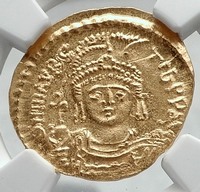
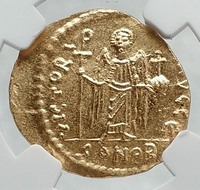
Byzantine Empire
Maurice Tiberius - Emperor: August 13, 582-November 22, 602 A.D.
Gold Solidus 21mm (4.43 grams) Antioch Mint, 5th Officina, struck circa 583-602 A.D.
Reference: Sear 478 or 524
O N mAVRC-TIb P P AV, pearl-diademed, helmeted, draped and cuirassed bust of Maurice Tiberius facing, globus cruciger in right hand.
VICTORIA AVG G Є, Angel standing facing, long staff terminating in staurogram (Tau-Rho) in right hand, globus cruciger in left; CONOB in exergue.
See all Jesus Gold coins
CONSTANTINE VII Authentic Ancient Byzantine GOLD Coin w JESUS CHRIST NGC i71690
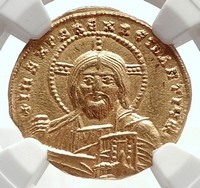
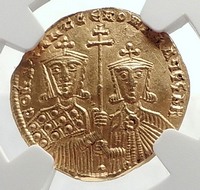
Byzantine Empire
Constantine VII, Porphyrogenitus - Emperor: June 6, 913 A.D. - November 9, 959 A.D.
Gold Solidus 19mm (4.46 grams) Constantinople mint, 950-955 A.D.
Reference: DOC 15. Sear 1751
+IhS XPS RЄX RЄςNANTIЧM, Facing bust of Christ Pantocrator, wearing tunic, himation and a cross nimbus with three pellets in the arms, raising right hand in benediction and holding book of Gospels in his left.
CONSTANT' CЄ ROMAh' AЧςς bR', Crowned facing busts of Constantine VII, bearded and wearing loros on the left, and Romanus II, beardless and wearing chlamys on the right; both holding, between them with their right hands, a long patriarchal cross.
SEE ALL Anonymous Jesus or Crusader Coins
Item: i80780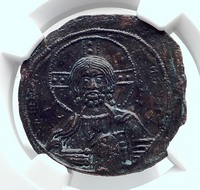
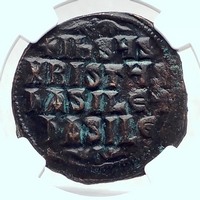
Byzantine Empire - Anonymous Class A3
Bronze Follis 27mm (10.92 grams) struck circa 1020-1028 A.D.
Reference: Sear 1813
Certification: NGC Ancients MS Strike: 4/5 Surface: 2/5 4935021-017
+ ЄMMANOVHΛ, Bust of Jesus Christ facing, wearing a nimbus crown, pallium and colobium, and holding book of Gospels with both hands; IC XC to left and right of bust.
+IhSЧS / XRISTЧS / bASILЄЧ / bASILЄ ("Jesus Christ King of Kings") in four lines.
For more than a century, the production of Follis denomination Byzantine coins had religious Christian motifs which included included Jesus Christ, and even Virgin Mary. These coins were designed to honor Christ and recognize the subservient role of the Byzantine emperor, with many of the reverse inscriptions translating to "Jesus Christ King of Kings" and "May Jesus Christ Conquer". The Follis denomination coins were the largest bronze denomination coins issued by the Byzantine empire, and their large size, along with the Christian motif make them a popular coin type for collectors. This series ran from the period of Byzantine emperors John I (969-976 A.D.) to Alexius I (1081-1118 A.D.). The accepted classification was originally devised by Miss Margaret Thompson with her study of these types of coins. World famous numismatic author, David R. Sear adopted this classification system for his book entitled, Byzantine Coins and Their Values. The references about this coin site Mr. Sear's book by the number that they appear in that work. The class types of coins included Class A1, Class A2, Class A3, Class B, Class C, Class D, Class E, Class F, Class G, Class H, Class I, Class J, Class K.
Read the JESUS CHRIST Anonymous Class A-N Byzantine Follis Coins Reference and Guide
See ALL coins bearing Jesus Christ or related available for sale.
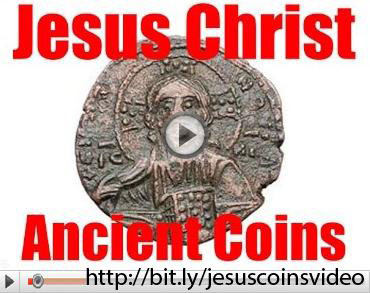
SEE ALL Crusades or Crusader Coins available
1324 CYPRUS Crusader Kingdom HUGH IV Antique Silver GROS Coin CROSS NGC i80406
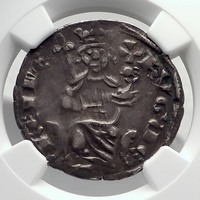
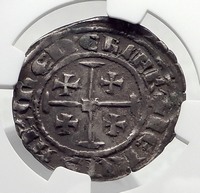
Cyprus as Crusader State Kingdom of Cyprus
Hugh IV- King: 31 March 1324 – 24 November 1358 A.D.
Silver Gros 27mm (4.60 grams)
Reference: Malloy 67
+ hVGVЄ | RЄI DЄb King seated on curule chair.
+ IЄRVSAL'M Є D' ChIPR (Translation: Jerusalem and Cyprus), Cross of Jerusalem.
Item: i80420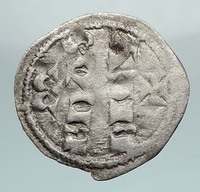
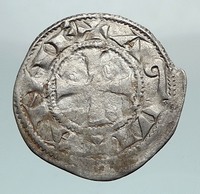
Richard I "The Lionheart"- King: 3 September 1189 - 6 April 1199
King Richard's Crusade
1169-1189 Denier 19mm (0.71 grams)
Reference: PA# 2768, El# 4
+ RICA RDVS ω, Text encircled.
+ AGVITANIE, Cross encircled.
Guide to Biblical Coins by David Hendin 5th Edition
https://www.amazon.com/Guide-Biblical-Coins-David-Hendin/dp/0965402959/
Money of the Biblie, 3rd Edition by Kenneth Bressett (Author)
https://www.amazon.com/gp/product/079483955X/
Coins and the Bible by Richard Abdy (Author), Amelia Dowler (Author)
https://www.amazon.com/Coins-Bible-Richard-Abdy/dp/1907427309/
Best Place to Buy Ancient Coins Online & FAQwww.TrustedCoins.comeBay Store with over 19,000 Items 20,000 Positive ReviewsFrequently Asked Questions
Who am I dealing with?
How long until my order is shipped?
How will I know when the order was shipped?
What is a certificate of authenticity and what guarantees do you give that the item is authentic?
Is there a money back guarantee?
When should I leave feedback?
How and where do I learn more about collecting ancient coins?
|